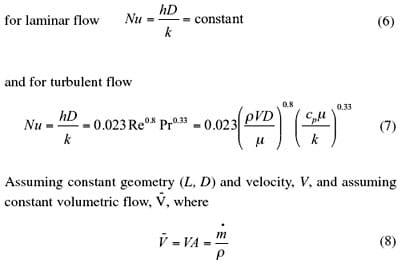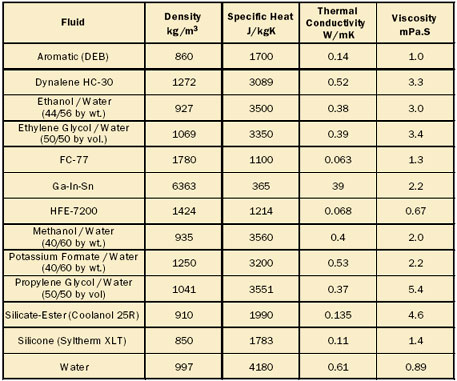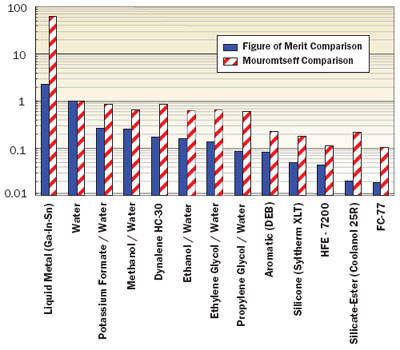In the May 2006 issue the Calculation Corner focused on the comparison of liquid coolants using the Mouromtseff number [1]. For single phase forced convection, Mouromtseff found this figure of merit, Mo, to follow the form
where ρ, k, cp, and � represent the density, thermal conductivity, specific heat (at constant pressure) and dynamic viscosity of the fluid. The exponents a, b, d, and e take on values appropriate to the heat transfer mode of interest and the corresponding heat transfer correlation.
However, in addition to a fluid’s heat transfer capability, the fluid’s ability to store and move heat away from a heat source and the fluid’s hydraulic performance should also be considered for optimum system performance. It is desirable to maximize the caloric and heat transfer capability while at the same time minimizing the hydraulic behavior, which is characterized by system pressure drop and required pumping power.
A figure of merit, FOM, representing the relationship among key thermophysical properties for comparative purposes has been suggested by Yeh and Chu [2] for single phase forced convection cooling that captures this desire
where h is the heat transfer coefficient for a particular mode of heat transfer, and P is the required pumping power. The pumping power, which is assumed for an incompressible fluid is
where ![]() is the mass flow rate, ΔP is the fluid pressure drop, and ρ ηp is the pump efficiency. The fluid pressure drop is assumed to be predominantly due to frictional loss, hence
is the mass flow rate, ΔP is the fluid pressure drop, and ρ ηp is the pump efficiency. The fluid pressure drop is assumed to be predominantly due to frictional loss, hence
 |
The constants a and b depend on whether the flow is laminar (a = 64, b = 1) or turbulent (a = 0.316, b = 0.25) [3]. Further, standard heat transfer expressions are assumed [4]
 |
The above equations can be combined and reduced in terms of the fluid properties to yield Figures of Merit for the following flow regimes:
 |
These expressions (equations 9 and 10) will be used to compare various fluids by normalizing the FOM for a given fluid to the FOM for water.
Table 1: Thermophysical Properties of Selected Coolants
 |
Table 1 lists the thermophysical properties for selected fluids. Figure 1 shows the comparison of the various fluids to water for the laminar flow regime. The general trend for fluids based on the FOM is similar to the comparison made for the fluids based solely on heat transfer based on the Mouromtseff number [1]. Note, however, that liquid metal, the one fluid that ranks higher than water, does not fair nearly as well when compared by FOM (2.3X) as when compared by the Mouromtseff number (64X). Similarly, for fluids that rank lower than water, there is a greater disparity when the comparison is based on the FOM rather than on the Mouromtseff number. This is particularly true of the aqueous solutions, which compare rather closely to water if based solely on heat transfer.
 |
Figure 1: Fluid Comparison – Laminar FlowFigure 2 outlines the comparison of the various fluids to water for the turbulent flow regime. First, note that liquid metal would rank best if based on heat transfer alone but compares less favorably to water when based on the FOM. Again, as with the laminar flow comparisons, the ratios based on FOM are more pronounced than those based on the Mouromtseff number.
 |
Figure 2: Fluid Comparison – Turbulent FlowA Figure of Merit for comparing fluids based on single phase convective heat transfer and both caloric and hydraulic behavior has been presented. However, as outlined in the May 2006 Calculation Corner, it is important to remember that a liquid coolant can not be selected based on FOM alone; other factors such as materials compatibility, cost, and environmental considerations must also be considered [1,5].
References
- Simons, R.E., “Comparing Heat Transfer Rates of Liquid Coolants Using the Mouromtseff Number,” ElectronicsCooling, Vol. 12, No. 2, May 2006.
- Yeh, L.-T. and Chu, R.C., “Thermal Management of Microelectronic Equipment – Heat Transfer Theory, Analysis Methods, and Design Practices,” ASME Press, NY, 2002, pp. 261-265.
- White, F.M.,”Fluid Mechanics,” McGraw-Hill Book Company, NY, 1979.
- Incropera, F.P. and DeWitt, D.P., “Fundamentals of Heat and Mass Transfer – Third Edition,” John Wiley and Sons, NY, 1990.
- Mohapatra, S.C., “An Overview of Liquid Coolants for Electronics Cooling,” ElectronicsCooling, Vol. 12, No. 2, May 2006.






